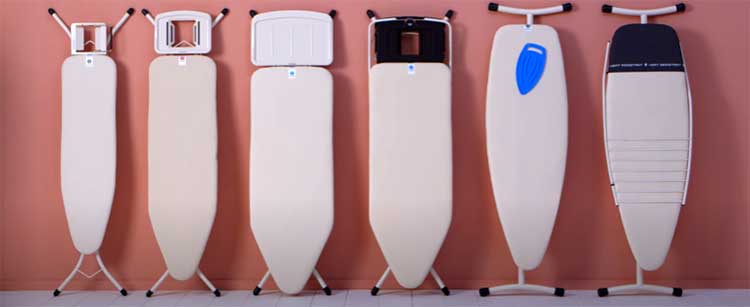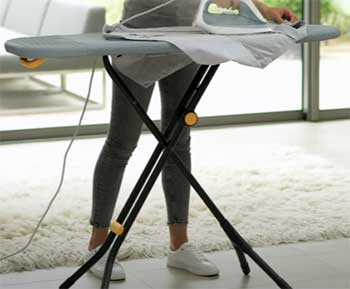Ironing is one of those household chores that few people actually enjoy, yet it’s necessary to keep clothes looking crisp and wrinkle-free.
And while irons themselves have gotten more advanced and expensive over the years, the humble ironing board has also seen a surplus of upgrades and premium features that come at a cost.
In today’s market, high-quality ironing boards often don’t come cheap, with prices ranging from $70 to over $300. But why exactly are these laundry room tools so pricey? There are a few key reasons driving up costs.
Reasons For Ironing Boards Being So Expensive
Here is a list of those reasons:
- Durable Materials Justify Higher Prices
- Innovative Design Extras Come at a Cost
- Robust Construction Commands Higher Prices
- Added Conveniences Contribute to Cost
- Space-Saving Designs Cost More Too
- Reputable Brand Names Cost Extra
- Unique Materials Push Up Prices
- Multi-Functional Designs Demand Bigger Budgets
- Superior Performance Commands Higher Costs
Let’s talk about those reasons in detail.
- Durable Materials Justify Higher Prices

One of the biggest factors affecting the price is the types of materials used to construct ironing boards. Cheaper boards tend to use thin steel or aluminum for the frame, legs, and body accompanied by low-density foam padding and basic polyester or cotton covers.
There’s nothing wrong with these materials per se, but they pale in comparison to premium options.
Higher-end ironing boards opt for much more durable and rugged metals like powder-coated steel, anodized aluminum, or even stainless steel. These provide maximum strength and corrosion resistance for years of guaranteed stability.
You’ll also find subtly perforated steel tops that allow steam to pass through for smoother gliding.
The padding and fabric covers are also steps above basic boards. Instead of flimsy padding that compresses easily, deluxe models incorporate high-density foam or woven felt that provide gentle support without impressions.
And 100% cotton or cotton/poly blends have largely replaced polyester for their breathability and lower heat retention.
Some boards even use silcone covers that withstand temperatures up to 500°F thanks to their highly durable woven fiberglass base. These are specially designed for pressing or steaming delicate fabrics.
In short, the combination of heavy-duty steel frames, commercial-grade padding, and heat-resistant fabric covers is the secret behind a board built to endure years of regular use. And naturally, more premium materials equate to higher retail prices.
- Innovative Design Extras Come At A Cost
Another reason some boards fetch such lofty prices is innovation. While basic boards simply fold out with four legs and a flat surface, today’s premium ironing boards incorporate clever design elements that improve both form and function.
For example, larger dimensions like 49” x 19” provide ample ironing surface area so you can smooth out king size sheets or tablecloths with ease. Some feature pull-out extensions for even more space. Built-in hanging racks allow you to suspend freshly pressed garments right on the board.
Handy iron rests ensure a secure home for your iron when not in use. Retractable cord minders keep cords neatly coiled and out of the way. Knee-activated lift mechanisms make it easy to adjust the height by simply leaning into the board.
Some even have integrated ironing board covers that zip or envelope around the board for smooth, seam-free surfaces. These thoughtful design details all contribute to a better ironing experience. But of course, such innovations drive up manufacturing costs.
- Robust Construction Commands Higher Prices

Here’s a fact that explains the harsh price difference between bargain boards and premium models: construction quality.
Flimsy boards made from low-grade steel and thin padding may cost less, but they tend to creak, wobble, and even collapse with regular use.
You essentially end up paying more in the long run to keep replacing cheap boards that bend and break.
On the other hand, reputable high-end ironing boards like Brabantia are built from scratch to last decades, not just years.
We’re talking 10x more durable frames, commercial-grade leg locks that won’t loosen, and rigorous stability testing. These boards are constructed like tanks able to withstand years of laundry days with zero issues of buckling or damage. It’s the very definition of “you get what you pay for.”
For instance, Brabantia’s frames undergo continuous robotic testing that simulates 10 years of daily use. Other brands tout similar extreme durability testing procedures as well. Plus solid hardwood legs look attractive while preventing rust.
When you consider the superior metals, rigid stability, and extreme testing high-end boards are subjected to, the investment pays dividends in the long run.
- Added Conveniences Contribute to Cost
You’ll notice that the most expensive ironing boards on the market also tend to pack the most convenience-focused features to boot. These additions are meant to make the chore of ironing easier, faster, and more efficient. But they also raise the price in the process.
Automatic cord reels that retract and store your iron’s cord are a prime example. No more wrestling with messy, tangled cords. Other built-in conveniences include magnetic iron rests, storage trays for laundry supplies, locking wheels for mobility, and garment hangers.
Some boards even have integrated LED lighting to illuminate your ironing surface, or Bluetooth speakers to listen to music or podcasts while you work.
While not completely necessary, these functional additions aimed at streamlining ironing do result in a more pleasurable user experience to help justify the price.
- Space-Saving Designs Cost More Too

One of the handiest upgrades you’ll find in premium ironing boards is space-saving functionality for compact homes. Standard boards stick out like a sore thumb in smaller laundry rooms.
But high-end boards address this through clever folding and storage designs. Retractable systems allow the boards to shrink down to a fraction of the full size. Wall-mounted boards save floor space when not in use.
Some models feature hidden storage drawers and cabinets built into the boards themselves. Others have wheels so they can easily tuck away in a closet or under the bed. This space-conscious ingenuity comes at a steeper price, but pays off if you’re limited on room.
- Reputable Brand Names Cost Extra
Like any home goods category, you’ll pay more for ironing boards sporting premium brand names like Rowenta, Brabantia, Honey-Can-Do, Household Essentials, and others compared to no-name boards.
But the brand reputation for quality is well-earned. For example, Brabantia offers a 10-year guarantee against any manufacturing defects. Their boards undergo intense prototyping and testing for unbeatable stability.
Other leading brands also have long-standing legacies for durable construction paired with stylish design. So while the brand name contributes somewhat to cost, it also signals a proven product.
- Unique Materials Push Up Prices
You’ll notice that some high-design ironing boards cost significantly more due to the use of unique materials beyond the standard metal and foam builds.
For instance, you can find solid wood ironing boards made from gorgeous bamboo, acacia, and other woods that certainly don’t come cheap. But they offer both decorative flair and natural heat/moisture-resistance.
Other material upgrades include lightweight aluminum frames for portability or even polyurethane coated covers. While pricier, these materials inject personality and customization into a traditionally utilitarian product.
- Multi-Functional Designs Demand Bigger Budgets
Some premium ironing boards blur the lines between single-use tool and versatile laundry room station. How so? Through built-in storage and organization features.
We’re talking fold-out shelves and drawers to store laundry essentials, retractable hangers, and built-in laundry bins that integrate right into the board.
Some high-end options even have drying racks or laundry sorter lids that convert the board into a multi-purpose laundry workspace. This adds incredible functionality, but also ratchets up the price considerably.
- Superior Performance Commands Higher Costs
Here’s an interesting fact: the higher price tags on premium ironing boards actually correspond with superior performance and results. You really do get what you pay for.
The sturdy construction prevents teetering and wobbling, so you can iron with total control and precision. The coated metal or wood surfaces provide smooth, snag-free gliding. Thick padding absorbs pressure and heat instead of transferring it to clothes. Custom size widths offer ample room for larger projects.
Features like garment hangers, cord minders, and iron rests shave precious minutes off the chore. So when considering the cumulative performance benefits, suddenly that $150 price seems a bargain.
Also Read: Comparison of Rowenta And CHI Irons.
Frequently Asked Questions (FAQ)
For those who iron clothes frequently and want wrinkle-free results, a high-end ironing board is absolutely worth the investment. The sturdy construction prevents wobbling and creaking over years of use. Multi-layered padding and stainless steel or silicone covers offer the ideal smooth surface for seamless ironing. Added conveniences like cord management and storage racks save precious time. And adjustable/removable covers make it easy to keep the surface clean and pristine over time.
Basic metal ironing boards can be found for $20-30. Mid-tier boards made with nicer materials and padding run between $40-$60 typically. Premium feature-packed ironing boards from leading brands range from $70 up to $200+, depending on size, materials used, and extra features. Unique solid wood boards cost over $200 as well. But the average cost of a standard full-size ironing board is $60-100.
A quality ironing board makes a tremendous difference compared to ironing on a countertop or rickety board. The ideal ironing surface is sturdy without creaking or wobbling, gently padded to prevent impressions but not overly thick, and has a smooth gliding cover that repels heat and moisture. Premium boards check all these boxes for frustration-free ironing every time. Good boards save time, effort, and give wrinkle-free results in half the time thanks to purposeful designs. It’s very much a ‘you get what you pay for’ product.
An ironing board is by no means an essential household item, but it certainly makes the chore of ironing easier, faster and achieves better results. Trying to iron on a table or bed often leads to awkward maneuvering, uneven pressure, and subpar results. A sturdy ironing board with padded cover allows you to smoothly glide the hot iron over garments fully spread out and flush to the surface. So while not mandatory, an ironing board pays for itself in time and effort saved. For frequent or heavy-duty ironing, it’s a worthwhile investment.
In Conclusion
Premium ironing boards certainly represent a larger up-front investment than bargain boards, sometimes 4-5x as much.
But taken collectively, the durable materials, innovative designs, robust construction, added conveniences, space-saving sizes, brand reputation, and multi-functionality explain why the most feature-rich models sell for upwards of $200.
While basic boards get the job done, investing in a high-quality ironing board pays dividends through superior performance, time-saving features, and longevity measuring decades rather than years. And crease-free clothes are priceless.
So if you find yourself ironing frequently and want to upgrade your experience, consider a top-tier board. Just make sure to match the size, dimensions, and features to your needs and space.
With some smart selective shopping, you can find a premium iron board that justifies the price through years of better ironing.
